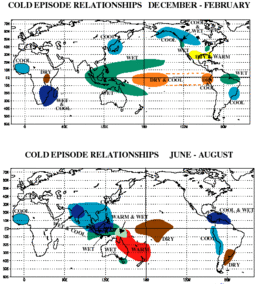La Niña

La Niña is a coupled ocean-atmosphere phenomenon similar to El Niño. During a period of La Niña, the sea surface temperature across the equatorial Eastern Central Pacific Ocean will be lower than normal by 0.5 °C. In the United States, an episode of La Niña is defined as a period of at least 5 months of La Niña conditions. The name La Niña originates from Spanish, meaning "the little girl", analogous to El Niño meaning "the little boy".
La Niña is the opposite of El Niño, where the latter corresponds instead to a higher sea surface temperature by a deviation of at least 0.5 °C. El Niño is famous due to its potentially catastrophic impact on the weather along both the Chilean and Australian coasts. Furthermore, La Niña is often preceded by a strong El Niño.
Effects of La Niña

La Niña causes mostly the opposite effects of El Niño, for example, El Niño would cause a wet period in the Midwestern U.S., while La Niña would typically cause a dry period.
In simple terms, whereas El Niño causes drier weather on West Pacific seaboards, ie. Eastern Australia or Southeast Asia, and wetter, humid weather in the East Pacific, ie. Western Americas; La Niña causes opposite conditions, although usually to a lesser extreme.
Recent occurrences
November El Niño/Southern Oscillation Diagnostic Discussion, and that it will likely continue into 2008. According to NOAA, "Expected La Niña impacts during November – January include a continuation of above-average precipitation over Indonesia and below-average precipitation over the central equatorial Pacific. For the contiguous United States, potential impacts include above average precipitation in the Northern Rockies, Northern California, and in southern and eastern regions of the Pacific Northwest. Below-average precipitation is expected across the southern tier, particularly in the southwestern and southeastern states. "[1] In March 2008, La Niña caused a drop in sea surface temperatures over Southeast Asia by an astronomical amount of 2°C. It also caused heavy rains over Malaysia, Singapore and Indonesia. "[2]
See also
- El Niño-Southern Oscillation (Main article on El Niño and the related Southern Oscillation, discussing the relation between these two and La Niña)
- Walker circulation
